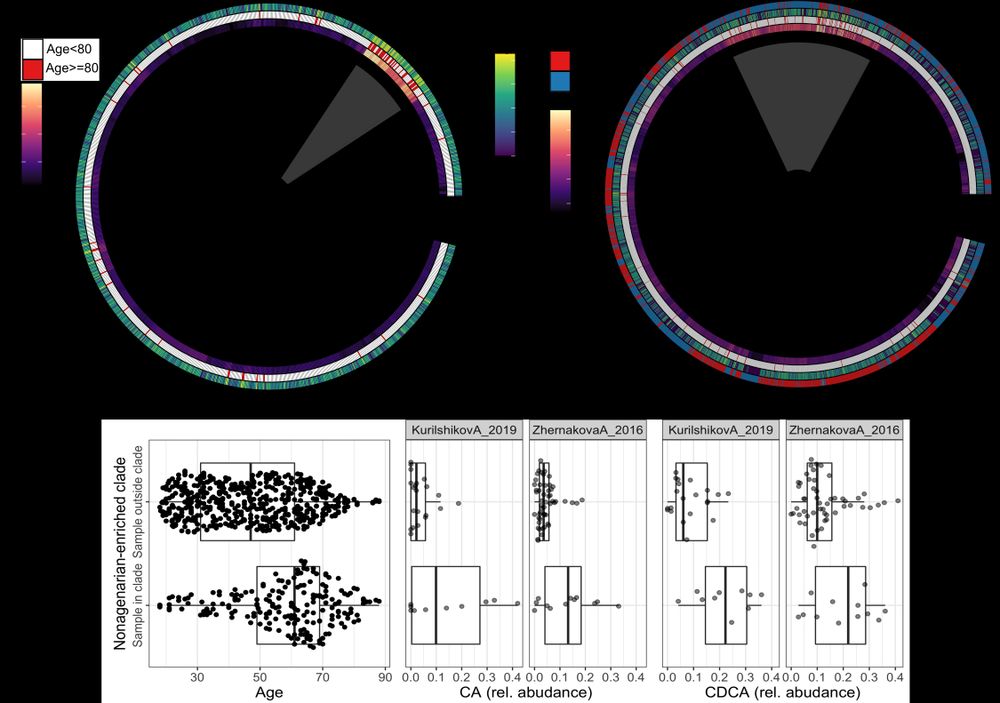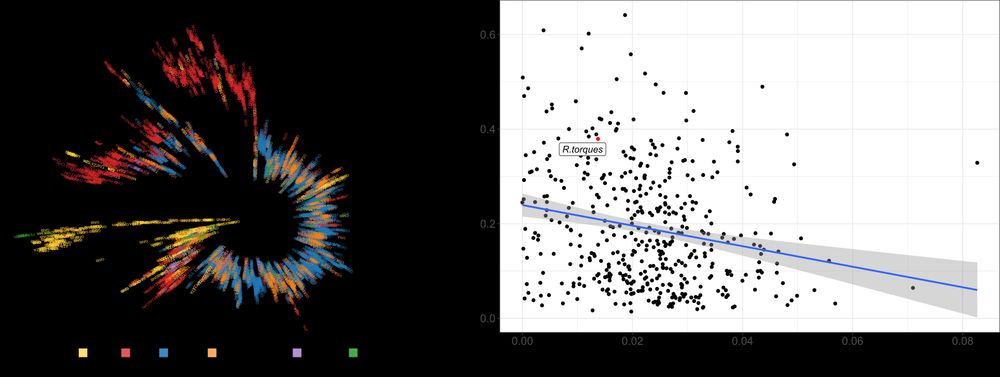Sergio Andreu-Sanchez
@seandreu.bsky.social
Postdoctoral researcher at @raeslab.org, former Groningen Microbiome Hub.
(meta)Genomics, bioinformatics
(meta)Genomics, bioinformatics
This was seen in totally different human populations (European and Asian), meaning that is unlikely driven by lifestyle common to elders.
Overall we do not know why this is happening, but might highlight a lineage that is better adapted to gut conditions later in life (2/2)
Overall we do not know why this is happening, but might highlight a lineage that is better adapted to gut conditions later in life (2/2)
May 5, 2025 at 2:32 PM
This was seen in totally different human populations (European and Asian), meaning that is unlikely driven by lifestyle common to elders.
Overall we do not know why this is happening, but might highlight a lineage that is better adapted to gut conditions later in life (2/2)
Overall we do not know why this is happening, but might highlight a lineage that is better adapted to gut conditions later in life (2/2)
Sure June!
Ruminoccocus gravus is a common member of the gut microbiome. When we looked into the genetics of this bacterium, we saw that older individuals harbored bacteria of similar genetics makeup, while this was not observed in younger people. (1/2)
Ruminoccocus gravus is a common member of the gut microbiome. When we looked into the genetics of this bacterium, we saw that older individuals harbored bacteria of similar genetics makeup, while this was not observed in younger people. (1/2)
May 5, 2025 at 2:32 PM
Sure June!
Ruminoccocus gravus is a common member of the gut microbiome. When we looked into the genetics of this bacterium, we saw that older individuals harbored bacteria of similar genetics makeup, while this was not observed in younger people. (1/2)
Ruminoccocus gravus is a common member of the gut microbiome. When we looked into the genetics of this bacterium, we saw that older individuals harbored bacteria of similar genetics makeup, while this was not observed in younger people. (1/2)
Big thanks to the researchers and participants behind the studies we used, the Curated curatedMetagenomicData team for making these datasets accessible, and Lifelines for providing cohort and phenotypic data. 🙏 (11/n)
April 30, 2025 at 4:15 PM
Big thanks to the researchers and participants behind the studies we used, the Curated curatedMetagenomicData team for making these datasets accessible, and Lifelines for providing cohort and phenotypic data. 🙏 (11/n)
Special thanks to Nicola for hosting me in his lab in @CIBIO @CIBIO_UniTrento—an inspiring few months of great science! Grateful to @embo.org EMBO for funding this experience. (10/n)
April 30, 2025 at 4:15 PM
Special thanks to Nicola for hosting me in his lab in @CIBIO @CIBIO_UniTrento—an inspiring few months of great science! Grateful to @embo.org EMBO for funding this experience. (10/n)
This has been a fantastic collaboration between the Groningen Microbiome Hub team and @cibiocm.bsky.social. Huge thanks to all the amazing team members from both groups! (8/n)
April 30, 2025 at 4:15 PM
This has been a fantastic collaboration between the Groningen Microbiome Hub team and @cibiocm.bsky.social. Huge thanks to all the amazing team members from both groups! (8/n)
While in this work we are unable to assess what is the cause of such associations, we highlight the intriguing links between bacterial strains and human phenotypes.
We provide a list of strain-phenotype associations and large phylogenies, hoping they’ll spark further interest in the community. (7/n)
We provide a list of strain-phenotype associations and large phylogenies, hoping they’ll spark further interest in the community. (7/n)
April 30, 2025 at 4:15 PM
While in this work we are unable to assess what is the cause of such associations, we highlight the intriguing links between bacterial strains and human phenotypes.
We provide a list of strain-phenotype associations and large phylogenies, hoping they’ll spark further interest in the community. (7/n)
We provide a list of strain-phenotype associations and large phylogenies, hoping they’ll spark further interest in the community. (7/n)
C. aerofaciens phylogeny showed a melanoma-enriched clade across diverse studies.
Interestingly, individuals with prostate cancer also clustered here! (6/n)
Interestingly, individuals with prostate cancer also clustered here! (6/n)

April 30, 2025 at 4:15 PM
C. aerofaciens phylogeny showed a melanoma-enriched clade across diverse studies.
Interestingly, individuals with prostate cancer also clustered here! (6/n)
Interestingly, individuals with prostate cancer also clustered here! (6/n)
The phylogeny of R. gnavus displayed a clade most commonly seen in older individuals. We observed this clade in both Asian and European studies, and found a distinct bile acid profile in those individuals harboring this R. gnavus clade. (5/n)

April 30, 2025 at 4:15 PM
The phylogeny of R. gnavus displayed a clade most commonly seen in older individuals. We observed this clade in both Asian and European studies, and found a distinct bile acid profile in those individuals harboring this R. gnavus clade. (5/n)
Human phenotypes also clustered with species phylogenies.
Association analysis revealed multiple phenotype–species links, including strong, reproducible associations between R. gnavus and age, and C. aerofaciens and melanoma. (4/n)
Association analysis revealed multiple phenotype–species links, including strong, reproducible associations between R. gnavus and age, and C. aerofaciens and melanoma. (4/n)
April 30, 2025 at 4:15 PM
Human phenotypes also clustered with species phylogenies.
Association analysis revealed multiple phenotype–species links, including strong, reproducible associations between R. gnavus and age, and C. aerofaciens and melanoma. (4/n)
Association analysis revealed multiple phenotype–species links, including strong, reproducible associations between R. gnavus and age, and C. aerofaciens and melanoma. (4/n)
Phylogenies revealed geographic stratification 🌎.
Species with stronger stratification were less often shared across individuals, suggesting limited dispersal drives the observed geographic patterns. (3/n)
Species with stronger stratification were less often shared across individuals, suggesting limited dispersal drives the observed geographic patterns. (3/n)

April 30, 2025 at 4:15 PM
Phylogenies revealed geographic stratification 🌎.
Species with stronger stratification were less often shared across individuals, suggesting limited dispersal drives the observed geographic patterns. (3/n)
Species with stronger stratification were less often shared across individuals, suggesting limited dispersal drives the observed geographic patterns. (3/n)
Strain-level genetic variation can shape host–microbe interactions 🦠🧬 .
We analyzed >32,000 public metagenomes, profiled species marker genes at single-nucleotide resolution with StrainPhlAn, and built ~600 species phylogenies. (2/n)
We analyzed >32,000 public metagenomes, profiled species marker genes at single-nucleotide resolution with StrainPhlAn, and built ~600 species phylogenies. (2/n)

April 30, 2025 at 4:15 PM
Strain-level genetic variation can shape host–microbe interactions 🦠🧬 .
We analyzed >32,000 public metagenomes, profiled species marker genes at single-nucleotide resolution with StrainPhlAn, and built ~600 species phylogenies. (2/n)
We analyzed >32,000 public metagenomes, profiled species marker genes at single-nucleotide resolution with StrainPhlAn, and built ~600 species phylogenies. (2/n)

